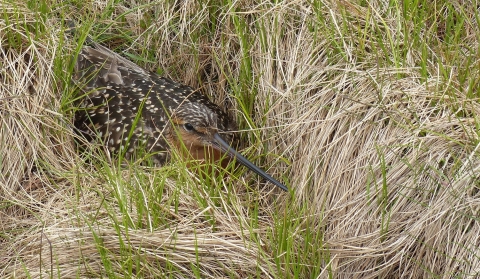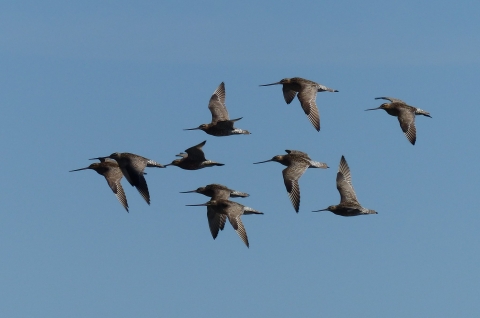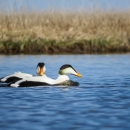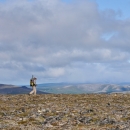States
AlaskaOverview
The Alaska-breeding Bar-tailed Godwit (Limosa lapponica baueri), a shorebird known as Cugerpak in Yup’ik and Kūaka in Māori, has experienced significant population declines. The main reason for these declines is believed to be the loss of feeding grounds in the Yellow Sea, where they stop to rest and eat during their spring migration. However, other factors on their Alaska breeding grounds, like hunting pressure and unsuccessful nests, may also be negatively affecting them.
Baueri Bar-tailed Godwits nest in three discrete regions of Alaska: the Arctic Coastal Plain, the Seward Peninsula, and Yukon-Kuskokwim Delta (Y-K Delta). Breeding season surveys have found that most Bar-tailed Godwits nest on the Y-K Delta and post-breeding adults and juveniles mix on the Delta's productive intertidal areas for up to two months, preparing for their 7,500 mile, 8-day flight to New Zealand and Australia—the longest non-stop migration of any animal. This amazing migration is the equivalent to running 288 consecutive marathons without eating, drinking, or resting. The Bar-tailed Godwit has captivated people around the world and made it a symbol of interconnectedness among ecosystems and cultures.
The Y-K Delta is within the traditional homeland of the Indigenous Central Yup'ik people. Yup'ik people have lived on the Delta for thousands of years and developed a culture and way of life centered on harvesting and using wild foods and materials, which is referred to as the subsistence way of life. Their harvesting activities follow the seasonal cycles of abundance of animals and plants. By living in close contact with nature, Indigenous peoples have accumulated traditional ecological knowledge. Shorebirds are not main food sources, but they improve food security and are related to key values of the Yup'ik culture. For these reasons, Yup'ik people are important partners in shorebird conservation.
Conservation and management actions that are developed with participation from local users benefit from local knowledge and perspectives, ownership, and durability. Therefore, the overarching goal for this project is to develop collaborative partnerships to guide research, harvest management, and conservation of the Bar-tailed Godwit at key sites on the Y-K Delta.
Specifically, this project will implement a multi-stage process with the following objectives:
- Build and strengthen partnerships among Indigenous communities and tribal councils, and state and federal agencies based on open, cross-cultural communication in order to integrate diverse ways of knowledge.
- Create opportunities for cross-cultural training, education, and outreach including establishing connections among peoples and Indigenous cultures of Alaska and New Zealand.
We believe that achieving these initial objectives will facilitate the implementation of additional objectives, which we will prioritize in future projects:
- Co-design objectives and methods to assess harvest sustainability in Alaska.
- Co-design and conduct collaborative research that incorporates local and traditional knowledge.
- Inform actionable and socially-just flyway-scale conservation and management decisions.
Importance of this Work
Effective conservation of Bar-tailed Godwits relies upon integrating local knowledge from the people that live with and depend on it for food. Co-production of knowledge of this imperiled population ensures a shared understanding of its cultural importance as well as its ecological requirements, status, threats, and the actions needed for continued sustainability.
Actions WE ALL can take
Giving them Space. Beach/coastal walking, a seemingly harmless activity, can have negative consequences on shorebirds, like the baueri Bar-tailed Godwit, that are using the area for rest, foraging, or nesting. In some parts of the U.S., human disturbance is one of the most significant threats to shorebird populations. These threats can intensify as human use (coastal recreation, off-leash dogs) in these coastal areas increases, leading to an overall reduction in suitable, undisturbed habitats for shorebirds.
If you are recreating near a coastline, shoreline, or other wetland type used by shorebirds, please give the shorebirds space—ideally, do not approach within 200 m (656 ft.). If you are recreating with a dog, please keep your dog leased, as the presence of dogs is directly related to shorebirds expending more energy being alert to their presence. If you are located in Anchorage, the municipal law requires you to restrain your dog in public places unless you are in a designated off-lease dog park. Learn more about how leashing your dogs protects birds from the National Audubon Society.
Participating in citizen science. Anyone can contribute valuable data by submitting what they see to citizen science programs like eBird or becoming an International Shorebird Survey volunteer. Shorebirds lend themselves to being quite visible outside the breeding season, congregating in large flocks and utilizing visible habitats like beaches and shorelines. Casual bird sightings can be a valuable data points for scientists. By submitting your bird sightings to eBird, or participating in the International Shorebird Survey you can play a crucial role in helping scientists monitor shorebirds.
Spreading the Word: Share information about shorebirds and their threats with your family, friends, and neighbors. Talk to them about how sustained public support are crucial to ensure the future of this group of birds.








